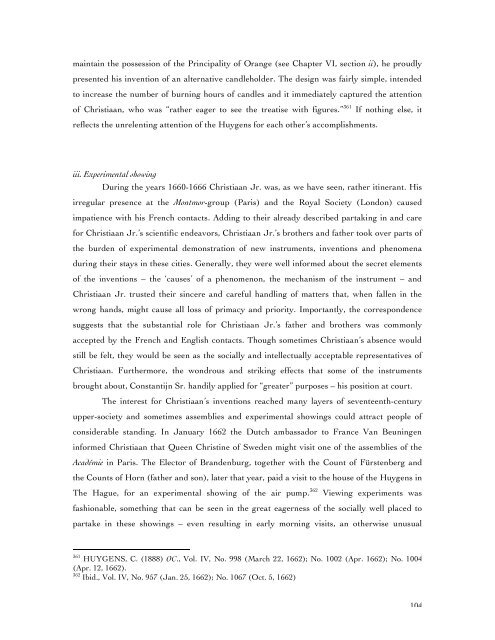Christiaan Huygens – A family affair - Proeven van Vroeger
Christiaan Huygens – A family affair - Proeven van Vroeger
Christiaan Huygens – A family affair - Proeven van Vroeger
Create successful ePaper yourself
Turn your PDF publications into a flip-book with our unique Google optimized e-Paper software.
maintain the possession of the Principality of Orange (see Chapter VI, section ii), he proudly<br />
presented his invention of an alternative candleholder. The design was fairly simple, intended<br />
to increase the number of burning hours of candles and it immediately captured the attention<br />
of <strong>Christiaan</strong>, who was “rather eager to see the treatise with figures.” 361 If nothing else, it<br />
reflects the unrelenting attention of the <strong>Huygens</strong> for each other’s accomplishments.<br />
iii. Experimental showing<br />
During the years 1660-1666 <strong>Christiaan</strong> Jr. was, as we have seen, rather itinerant. His<br />
irregular presence at the Montmor-group (Paris) and the Royal Society (London) caused<br />
impatience with his French contacts. Adding to their already described partaking in and care<br />
for <strong>Christiaan</strong> Jr.’s scientific endeavors, <strong>Christiaan</strong> Jr.’s brothers and father took over parts of<br />
the burden of experimental demonstration of new instruments, inventions and phenomena<br />
during their stays in these cities. Generally, they were well informed about the secret elements<br />
of the inventions <strong>–</strong> the ‘causes’ of a phenomenon, the mechanism of the instrument <strong>–</strong> and<br />
<strong>Christiaan</strong> Jr. trusted their sincere and careful handling of matters that, when fallen in the<br />
wrong hands, might cause all loss of primacy and priority. Importantly, the correspondence<br />
suggests that the substantial role for <strong>Christiaan</strong> Jr.’s father and brothers was commonly<br />
accepted by the French and English contacts. Though sometimes <strong>Christiaan</strong>’s absence would<br />
still be felt, they would be seen as the socially and intellectually acceptable representatives of<br />
<strong>Christiaan</strong>. Furthermore, the wondrous and striking effects that some of the instruments<br />
brought about, Constantijn Sr. handily applied for “greater” purposes <strong>–</strong> his position at court.<br />
The interest for <strong>Christiaan</strong>’s inventions reached many layers of seventeenth-century<br />
upper-society and sometimes assemblies and experimental showings could attract people of<br />
considerable standing. In January 1662 the Dutch ambassador to France Van Beuningen<br />
informed <strong>Christiaan</strong> that Queen Christine of Sweden might visit one of the assemblies of the<br />
Académie in Paris. The Elector of Brandenburg, together with the Count of Fürstenberg and<br />
the Counts of Horn (father and son), later that year, paid a visit to the house of the <strong>Huygens</strong> in<br />
The Hague, for an experimental showing of the air pump. 362 Viewing experiments was<br />
fashionable, something that can be seen in the great eagerness of the socially well placed to<br />
partake in these showings <strong>–</strong> even resulting in early morning visits, an otherwise unusual<br />
361<br />
HUYGENS, C. (1888) OC., Vol. IV, No. 998 (March 22, 1662); No. 1002 (Apr. 1662); No. 1004<br />
(Apr. 12, 1662).<br />
362<br />
Ibid., Vol. IV, No. 957 (Jan. 25, 1662); No. 1067 (Oct. 5, 1662)<br />
104


